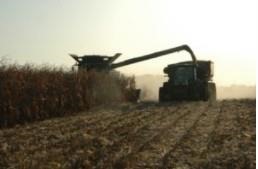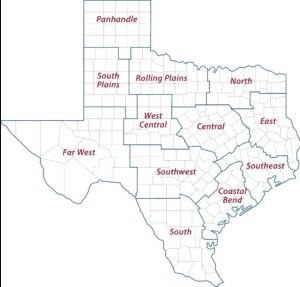By Adam Russell
High corn prices are causing a ripple effect throughout the U.S. economy, and the 2021 growing season could be the difference between price stabilization or all-time record high prices, according to Texas A&M AgriLife Extension Service experts.

Tight supplies and high demand means corn prices could influence prices on everything from gasoline to steaks.
David Anderson, Ph.D., AgriLife Extension economist, Bryan-College Station, said higher corn prices and their effect on other crops like wheat and soybeans, as well as their subsequent impacts on everything from bread and pasta to fuel and industry or feed and meats, is showing how interrelated agriculture is to the U.S. economy.
Most gasoline is also a 10% mix of ethanol, which also puts demand on corn supplies, especially as the economy continues to gain steam and people are returning to normalized travel patterns, Anderson said. The price for food-grade corn is also tied to the price of corn destined for feed and fuel.
The ripples eventually will hit consumers, Anderson said.
“The key for folks to understand is that corn prices roll through everything else,” he said. “High grain prices mean meat will eventually cost more because input costs are up. And corn overlaps with other important crops like wheat and soybeans because prices influence what is planted on the available crop acres.”
Corn prices rise on tightening supplies
Average Texas cash corn prices hit $8 per bushel the first week of May, up from just under $6 per bushel in early March.
Mark Welch, Ph.D., AgriLife Extension grain economist, Bryan-College Station, said the market is highly speculative at this point due to a range of factors that boil down to tight supplies and high demand currently and uncertainty about domestic and foreign production this growing season.
A March U.S. Department of Agriculture survey report indicated U.S. producers were expected to plant 91.1 million acres of corn, which is up just 1% compared to last year. If those numbers remain the same and U.S. producers experience average to below-average yields, Welch said supplies will remain tight.
But Welch and Anderson expect growers to react to what the market is signaling and plant more corn acres than the March report indicated.
“That’s the question. The market is saying there is time to plant more corn for the December harvest-time contract, but will they increase corn acres,” Welch said. “Corn is more favorable for a net return, at least on paper, and that happened in April after the acres report came out.”
Welch said other factors support the idea that higher corn prices are likely to incentivize growers to plant more corn acres. U.S. corn acres were planted sooner than usual, and that trend typically means the final tally will be higher than the March report. Supplies are tight amid a potentially tightening market as South America, namely Brazil, and U.S. Corn Belt states like Iowa are experiencing drought, which could impact yields, all while high prices have not deterred Chinese demand for feed grains.
U.S. corn supplies are the lowest they’ve been since 2013, but still not as low as they were coming out of the 2012 drought, Welch said.
“It’s a tight supply situation right now,” he said. “Now, if we see more acres planted, the weather improves in South America and corn-producing states domestically, producing a good crop, then we could see things settle down. But if corn stocks get lower, there are problems with corn crops and things get tighter, then we could see all-time record corn prices.”
AgriLife Extension district reporters compiled the following summaries:

CENTRAL
No report.
ROLLING PLAINS
Temperatures were warmer, but some areas received up to 5 inches of beneficial rainfall. Pastures and rangeland were looking better each day, and livestock were in fair condition. Most wheat fields reached the headed stage.
COASTAL BEND
Conditions were windy, which helped dry out some flooded fields. Crops responded to recent rains and looked good. Some crops that stood in water seem to be greening back up. In some areas, field conditions were still saturated, which prevented any fieldwork. Some cotton was replanted. Rangeland and pasture conditions were improving daily. Livestock were continuing to find good quality forage, and body conditions were improving. Livestock water availability from ponds improved significantly. Cattle prices were steady to higher, but auction numbers were lower due to wet conditions. Pecan producers began spraying for first-generation pecan nut casebearer as weather allowed. Early season pecan tree nut loads looked good.
EAST
The district received substantial amounts of rainfall. Cherokee County reported as much as 7 inches in some areas. Pasture and rangeland conditions were good. Subsoil and topsoil conditions were adequate. Producers in Harrison County reported already getting a few cuttings of hay. Fertilizer prices were rising. Livestock were in fair to good condition. Insect populations increased. Feral hogs continued to damage hay meadows and pastures.
SOUTH PLAINS
Rain was in the forecast for some counties. Subsoil and topsoil moisture improved some, but rains were needed for planting. Producers were planting and preparing fields. Cattle were in good condition.
PANHANDLE
Northern and central areas reported short to adequate soil moisture, while southern areas reported short to very short soil moisture levels. Pasture and rangelands were in very poor to fair condition across the district and were declining in drier areas. Oats were in fair condition, and winter wheat was in poor to good condition. Producers were planting corn, chopping silage and laying wheat and triticale down for hay.
NORTH
Topsoil moisture throughout the district was adequate to surplus. Temperatures were warmer, and many fields were still soggy from recent heavy rains. Collin County reported light damage from a small tornado. Wheat and ryegrass pastures were ready to cut for hay, but fields were too wet to access. Spring pastures were looking nice. Producers were about two weeks behind schedule on typical forage production. Ryegrass just recently began to head out, and summer weeds were beginning to emerge. Bermuda grass was green and growing slowly but needed soil temperatures to warm. Winter wheat was doing well, but freeze damage was showing, and English grain aphids were heavy in spots. Corn improved dramatically following the rain, sunshine and some warmer temperatures. Livestock were in good condition. Spring-born calves were doing well.
FAR WEST
Temperatures were sporadic again, with highs in the upper-90s and lows in the mid-50s. Rainfall averages were very inconsistent throughout the district, with some areas getting none and others receiving almost 4 inches. Wind likely dried up moisture in areas that received minimal rainfall. Winter wheat was headed out for the most part. Some early planted wheat was rolled up for hay. Farmers in the northern parts of the district prepared fields for cotton and peanuts but had not planted yet. Dryland producers were pre-watering fields and still very concerned about cotton emergence. Corn made a little progress, but growth was inconsistent due to variable temperatures. Dryland sorghum was beginning to emerge in areas that received rains. Cattle producers turned bulls out for spring breeding and continued to feed livestock and wildlife even though rangeland conditions were improving. Grasses were beginning to grow. Mesquite and catclaw were blooming. Most ranches had shipped most of their older cows and most calves. Pecan producers began watering trees again up to two hours per day and were preparing for pecan nut casebearer moth sprays.
WEST CENTRAL
It was a warm, dry week for most of the district after receiving good rains the previous weekend. Soil moisture levels improved significantly, and stock tanks caught much-needed runoff. Forage was abundant in pastures, but cool-season grasses were maturing and will soon play out. Warm-season grasses were just beginning to break dormancy and will need continued rainfall to establish well before summer sets in. Trees were still showing the effects of Winter Storm Uri. Livestock were in fair condition. Insect pest numbers were increasing on livestock and in gardens.
SOUTHEAST
Soil moisture conditions continued to be very dry in some parts of the district and adequate in other areas. Rain was in the forecast for some counties. Some rice was being planted late, along with organic rice, which typically goes in late. Pastures were dry in some areas and saturated in others. Rangeland and pasture ratings were very poor to excellent, with good ratings being most common. Livestock were in fair condition overall. Soil moisture levels ranged from very short to adequate, with adequate levels being the most common.
SOUTHWEST
Temperatures were mild, and precipitation received across the district helped rangeland and pasture conditions improve. Producers were busy with pasture weed control and fertilization. Corn, cotton and sorghum looked good with cotton just starting to emerge. Wheat harvest should be starting soon. Producers were culling cattle herds. Cattle markets remained steady, and sheep and goat markets were high. Spring calving and shearing of sheep continued. Livestock were in fair to good condition.
SOUTH
Soil moisture levels were short to adequate in some areas and very short to short in other areas. La Salle County reported 2.5-6 inches of rainfall, while Live Oak reported 0.5-1.75 inches. Zapata County reported trace amounts up to 1 inch of rainfall, and parts of Hidalgo County received 1-4 inches. High temperatures and windy conditions were not helping moisture retainment. Jim Hogg County reported temperatures reached 102 degrees. Burn bans were put into effect in some drier counties. Cotton planting was complete in most areas. Cotton fields looked good, but some cotton producers were evaluating their fields after heavy rains washed some acres out. Wheat and oat harvest was underway. Corn fields were tasseling. Some tasseling fields were way behind normal production schedule. Grain sorghum was struggling. Peanut planting started. Pasture and rangeland conditions were improving in areas with more moisture. Prickly pears and mesquites were putting on tunas and beans, respectively. Supplemental feeding was reducing for some cattle producers, but pasture conditions continued to worsen for others. Some ranchers were providing feed and water to livestock and wildlife. Hay and feed prices continued to rise due to high demand and low supplies. Producers continued to thin cattle herds, but prices remained steady. Vegetable fields and Coastal Bermuda grass continued to receive irrigation. Onions and other vegetables were being harvested. Watermelon and honeydew melon harvests should begin soon. Sunflowers in northern Hidalgo County were in full bloom, and sesame planting was complete.
Source : tamu.edu